|
Special Features





Image Libraries


|
|
Blog
Stadiums aren’t about the money
|
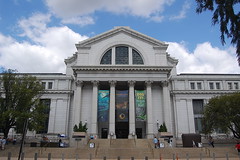
This doesn’t make money either.
Photo by \Ryan on flickr. |
Why do cities keep building stadiums, despite study after study showing they don’t make money? Simple: They’re cultural amenities that people want, and are willing to pay for.
When Mayor Gray announced the DC United stadium deal last month, he kicked off a public debate about stadium-building. Much of the debate has focused on whether or not the deal will make DC any money.
The fact that stadiums often lose money is largely irrelevant. So do museums, libraries, and opera houses. Stadiums fall into the same category.
Smart communities try to squeeze some economic development out of stadium deals, because they may as well, but that’s always a side benefit. At the end of the day it isn’t the main reason cities build stadiums.
It’s true that the privately-owned sports franchises that use stadiums reap a disproportionate benefit from public financing deals, but that’s also irrelevant to the stadium-building decision. Pro sports franchises are also cultural amenities that lots of people want and will pay for.
This is why decades of policy wonk hand-wringing over the money has rarely convinced anyone to stop building stadiums. That criticism, true as it is, simply does not invalidate the perceived benefit.
 Cross-posted at Greater Greater Washington. Cross-posted at Greater Greater Washington.
August 6th, 2013 | Permalink
Tags: development, economy, government

Denver proves Purple Line private funding can work
|
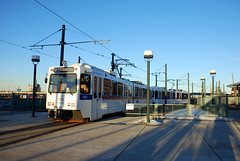
Denver is expanding its light rail system using private partners. |
Maryland Governor O’Malley is expected to announce today that the federal government has approved the Purple Line’s planning, and that Maryland will seek a private company to help pay for construction.
The idea is that a private company would pool its money together with state and federal funding to construct the Purple Line. The same company would then operate the line. In exchange, they would keep the fares, and Maryland would pay an annual contract fee.
With limited federal funds available, this type of public-private partnership is becoming common nationwide. DC is considering it for streetcars, but Denver offers a more instructive example.
In 2004, voters in Colorado passed a referendum for 122 miles of new rail transit in the Denver area. But the funding approved as part of that vote wasn’t adequate to build everything, so the transit agency had to find an alternate strategy. They’ve since approved two public-private partnerships, and are in the process of contracting a third.
Denver’s first partnership was for the Eagle P3 project, which is building 40 miles of electric commuter rail to the Denver suburbs and airport, at a cost of about $2 billion. The partnership is proceeding smoothly, with construction well underway and completion expected in 2016.
The second partnership is for a 10-mile-long suburban light rail extension. It began construction last year and is also expected to open in 2016.
The third will be for the 18-mile North commuter line. The transit agency put out a Request For Proposals in June, and is expected to select a partner company this fall.
All in all, Denver has or will soon have private partnerships to build almost 70 miles of new rail.
These deals do come with a cost. Typically the annual fee the state has to pay the partner is higher than the typical operating subsidy would be. So in essence, the operating cost is higher. But in exchange, the partner builds the line more quickly and sometimes more cheaply than the government could on its own.
Update: As expected, O’Malley announced the plan to use a partnership this afternoon. He also announced $680 million in state funds for the Purple Line, plus millions more for the Corridor Cities Transitway, Montgomery County Ride-On, and road projects.
August 5th, 2013 | Permalink
Tags: commuterrail, funding, government, lightrail, transportation

Northern Virginia picks transportation projects to fund
|

Almost $20 million will go to new VRE railcars. |
For years, leaders in Northern Virginia have been asking Richmond to let Northern Virginia raise its own money to spend on its own transportation priorities. They are finally getting the chance.
When the Virginia General Assembly passed a broad new transportation funding bill earlier this year, it included a section for Northern Virginia to raise and allocate hundreds of millions of dollars per year. Those new taxes began rolling in on July 1, with the beginning of Virginia fiscal year 2014.
On Wednesday night, the Northern Virginia Transportation Authority (NVTA) officially approved its first set of projects. The authority allocated about $210 million, split roughly evenly between transit and roads.
The largest projects include the Silver Line’s Innovation Center Metro station, new VRE railcars, and widenings along Route 28.
NVTA also approved a bond validation lawsuit that will preemptively ask Virginia courts to rule on NVTA’s legality. That process should take 6-9 months, and NVTA will have to wait until it’s over to actually start spending money. Taking the suit to court now means NVTA won’t have to spend years fending off other legal challenges.
The project list is shown below. For more details, see the project description sheets on NVTA’s website.
| Project |
Funding
in millions |
Location |
| Transit and multimodal projects |
| Innovation Center Metro station |
$41 |
Fairfax Co. |
| VRE railcars |
$19.8 |
Regional |
| VRE Lorton station 2nd platform |
$7.9 |
Fairfax Co. |
| WMATA buses |
$7 |
Regional |
| WMATA Orange Line traction power upgrades for 8-car trains |
$5 |
Regional |
| DASH buses |
$3.3 |
Alexandria |
| Potomac Yard Metro station environmental study |
$2 |
Alexandria |
| Crystal City multimodal center bus bays |
$1.5 |
Arlington |
| VRE Gainesville extension planning |
$1.5 |
Regional |
| VRE Alexandria station pedestrian tunnel & platform improvements |
$1.3 |
Alexandria |
| Herndon Metro station access improvements (road, bus, bike/ped) |
$1.1 |
Fairfax Co. |
| ART buses |
$1 |
Arlington |
| Leesburg park and ride |
$1 |
Loudoun |
| Loudoun County Transit buses |
$0.9 |
Loudoun |
| Route 7 Tysons-to-Alexandria transit alternatives analysis (phase 2) |
$0.8 |
Regional |
| Falls Church pedestrian access to transit |
$0.7 |
Falls Church |
| Duke Street transit signal priority |
$0.7 |
Alexandria |
| PRTC bus |
$0.6 |
Prince William |
| Alexandria bus shelters & real-time information |
$0.5 |
Alexandria |
| Van Buren pedestrian bridge |
$0.3 |
Falls Church |
| Falls Church bus shelters |
$0.2 |
Falls Church |
| Road projects |
| Rt 28 – Linton Hall to Fitzwater Dr |
$28 |
Prince William |
| Rt 28 – Dulles to Rt 50 |
$20 |
Fairfax Co. |
| Belmont Ridge Road north of Dulles Greenway |
$20 |
Loudoun |
| Columbia Pike multimodal improvements (roadway, sidewalk, utilities) |
$12 |
Arlington |
| Rt 28 – McLearen to Dulles |
$11.1 |
Fairfax Co. |
| Rt 28 – Loudoun “hot spots” |
$6.4 |
Loudoun |
| Chain Bridge Road widening |
$5 |
Fairfax City |
| Boundary Channel Dr interchange |
$4.3 |
Arlington |
| Rt 1 – Featherstone Rd to Mary’s Way |
$3 |
Prince William |
| Edwards Ferry Rd interchange |
$1 |
Loudoun |
| Herndon Parkway intersection with Van Buren St |
$0.5 |
Fairfax Co. |
| Herndon Parkway intersection with Sterling Rd |
$0.5 |
Fairfax Co. |
 Cross-posted at Greater Greater Washington. Cross-posted at Greater Greater Washington.
July 26th, 2013 | Permalink
Tags: BRT, bus, commuterrail, funding, government, lightrail, metrorail, roads/cars, transportation

Parking lots remain mandatory, whether you want them or not
|
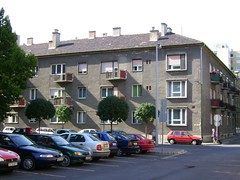
Photo by photobeppus on flickr. |
DC planning director Harriet Tregoning announced today that minimum parking requirements in transit-oriented neighborhoods will remain in the new zoning code.
As part of its rewrite of the zoning code, DC’s Office of Planning (DCOP) had proposed eliminating mandatory parking requirements in the densest, most transit-friendly parts of the city. Anyone who wanted to build parking would still be allowed to do so, but it wouldn’t be mandatory. The new zoning code will lower requirements for parking, but won’t eliminate them completely.
The new proposal will keep parking requirements for institutional and industrial land uses similar to what they are now. The requirement will drop by about half for residential and office buildings.
Under existing zoning, any new residential units are required to build parking spaces, whether the owner wants them or not. The requirement is a huge subsidy for drivers, and a major burden on car-free households. It also adds tremendously to the cost of new housing.
There is a silver lining: DCOP is still planning to eliminate parking requirements in downtown DC.
 Cross-posted at Greater Greater Washington. Cross-posted at Greater Greater Washington.
July 12th, 2013 | Permalink
Tags: government, roads/cars, transportation

Foxx has the makings of a great Transportation Secretary
|

Charlotte streetcar construction. Photo by Reconnecting America on flickr. |
President Obama yesterday nominated Charlotte Mayor Anthony Foxx as the next Secretary of Transportation. If Foxx’s experience in Charlotte is any indication, he’ll make a strong choice.
During his nomination press conference, Foxx said “cities have had no better friend” than the US Department of Transportation under outgoing Secretary Ray LaHood, and that if confirmed he would hope to “uphold the standards” LaHood set. That’s great news.
The fact that Foxx comes from a major central city is also a huge benefit. It means he understands urban needs, which aren’t just highways.
Charlotte may not be New York, but it’s made great strides in the right direction. The city’s first rail line opened a few years ago, and a streetcar line is under construction now. Charlotte also gained bronze-level status as a bike friendly community in 2008, and launched bikesharing in 2012.
Foxx has been a strong advocate for urban rail, especially streetcars. He knows transportation and land use are tied at the hip, and has fought repeated attacks on Charlotte’s streetcar by former Mayor and current North Carolina Governor Pat McCrory.
He’s also worked as an attorney for bus manufacturer DesignLine.
Foxx also knows that state Departments of Transportation can sometimes be part of the problem. At the federal level, it’s common for USDOT to delegate responsibilities and funding to state DOTs, under the assumption the states have a better understanding of local needs. But state DOTs aren’t any more local than any huge centralized government. And since they usually focus on highways, the result is that federal dollars mostly go to highways as well.
Since Foxx fought with the state over Charlotte’s streetcar, he knows that funneling everything through state DOTs means states hold the cards. He knows that can hurt cities.
Finally, Foxx hired Arlington, VA’s former county manager, Ron Carlee, to run Charlotte’s city government. Foxx would have heard about Arlington’s reputation for progressive transportation planning during the hiring process, and presumably counted it in Carlee’s favor.
Of course, no one can really predict what kind of Secretary Foxx will be. When progressive champion Ray LaHood was first tapped for the job, the blogosphere worried his history as a Republican from rural Illinois meant he’d be a status quo highway builder.
But we do know that Foxx has made a priority of building transit in his home city, and has had to fight to make it happen.
 Cross-posted at Greater Greater Washington. Cross-posted at Greater Greater Washington.
April 30th, 2013 | Permalink
Tags: bus, government, lightrail, people, roads/cars, streetcar, transportation

Silver Line Phase 1 looking great, Phase 2 contract imminentConstruction of the Silver Line Phase 1 remains on pace to finish in September. The construction team is testing the tracks and adding station details, including the finishing touches of the canopy at McLean station, shown below.
In Phase 2 news, authorities have identified Clark Construction and Kiewit Infrastructure to build the next phase, past Reston to Dulles and Loudoun County. An official contract is expected in May.
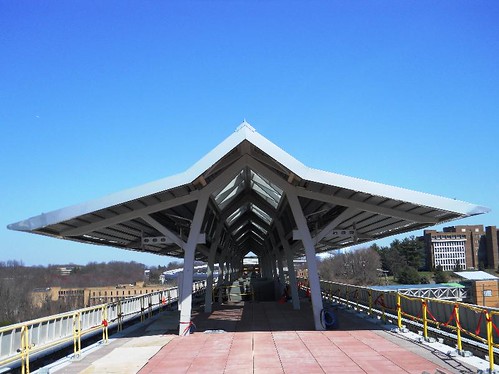
McLean Metro under construction. Photo by Stephen Barna of the Dulles Corridor Metrorail Project.
April 29th, 2013 | Permalink
Tags: government, metrorail, transportation

FBI headquarters could stay downtown, but at a cost
|

Rendering of potential H Street FBI building. Image from Arthur Cotton Moore via Washingtonian. |
As the FBI searches for a new headquarters location, most of the options have focused on the suburbs or Poplar Point, but Washingtonian reports on another proposal: Keep it downtown, at H Street and North Capitol Street, NW. But that location has serious downsides.
The proposal would repurpose the existing Government Printing Office buildings on North Capitol Street, and add a new extension to the west. The new building would be over 2 million square feet, and would cover multiple blocks from New Jersey Avenue to North Capitol.
Ideally an employer as large as the FBI should have its offices downtown, but the FBI isn’t just any employer. Its building is likely to be a security fortress, which means it won’t be very good for pedestrians, or have ground floor retail. H Street is an important pedestrian and retail spine. Giving up a long stretch of it to the FBI would be just as bad there as it is on E Street, where the FBI is a sidewalk dead zone.
Actually, a dead zone on H Street might be even worse. Walmart is building an urban format store directly across the street from the FBI proposal. And love Walmart or hate it, it’s going to be one of downtown’s biggest retail draws. That means this exact block of H Street is about to become one of the busiest retail main streets in the city. It should have retail on both sides.
One advantage of this FBI proposal is that the land is already owned by the government. That does mean it’s less likely to get retail on it, but putting the FBI building on it would cement that, literally.
There are other questions. DDOT’s proposed crosstown streetcar would run along H Street. The FBI has never weighed in on streetcars, but would they throw up security-related roadblocks? It’s unknown.
According to Washingtonian, the FBI would close G Street entirely to traffic. That further cripples the L’Enfant grid at a time when other projects are trying to restore the grid nearby. And would this forbid pedestrians and cyclists as well?
Finally, the existing GPO buildings are among Washington’s most prominent historic red brick buildings, and were designed by a prominent architect at the time. The FBI concept renderings show a courtyard in the middle of the GPO building, but aerials show no such courtyard currently exists. That suggests the buildings will have to be completely gutted to fit the FBI. Is that a worthy tradeoff?
Any proposal that keeps the FBI downtown merits serious consideration, but given the FBI’s security requirements, and given the potential for this location to be redeveloped with something even better, it may be preferable to let the FBI go. Putting the FBI on this block might be better than having it remain a parking lot, but almost any other building would be more ideal.
 Cross-posted at Greater Greater Washington. Cross-posted at Greater Greater Washington.
April 4th, 2013 | Permalink
Tags: development, government, urbandesign

Maryland, Virginia, fund these projects!
|
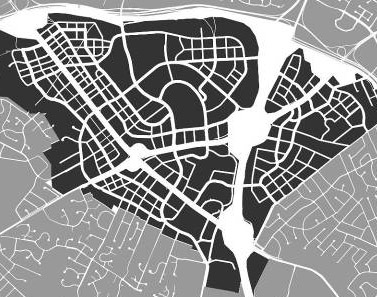
Tysons grid of streets, no. 2. |
Maryland and Virginia will both enact major new transportation funding bills this year. Neither bill says exactly which projects will be funded, but here are the top 10 projects in Maryland and Virginia that most deserve to get some of the funds.
Number 1: 8-car Metro trains. Metrorail is near capacity, especially in Virginia. More Metro railcars would mean more 8-car trains on the Orange, Blue, and Silver Lines.
Number 2: Tysons grid of streets. Tysons Corner has more office space than downtown Baltimore and Richmond put together. Converting it to a functional urban place is a huge priority.
Number 3: Purple Line. Bethesda, Silver Spring, Langley Park, College Park, New Carrollton. That’s a serious string of transit-friendly pearls. The Purple Line will be one of America’s best light rail lines on the day it opens.
Number 4: Baltimore Red Line. Baltimore has a subway line and a light rail line, but they don’t work together very well as a system. The Red Line will greatly improve the reach of Baltimore’s rail system.
Number 5: Silver Line Phase 2. The Silver Line extension from Reston to Dulles Airport and Loudoun County is one of the few projects that was earmarked in Virginia’s bill, to the tune of $300 million.
Number 6: Arlington streetcars. The Columbia Pike and Crystal City streetcars both have funding plans already, but could potentially be accelerated.
Number 7: Route 7 transit. Leesburg Pike is the next Rosslyn-Ballston corridor waiting to happen. Virginia is just beginning to study either a light rail or BRT line along it.
|

Corridor Cities Transitway, no. 8. |
Number 6: Corridor Cities Transitway. Gaithersburg has been waiting decades for a quality transit line to build around. BRT will finally connect the many new urbanist communities there, which are internally walkable but rely on cars for long-range connections.
Number 9: MARC enhancements. MARC is a decent commuter rail, but it could be so much more. Some day it could be more like New York’s Metro North or Philadelphia’s SEPTA regional rail, with hourly trains all day long, even on weekends.
Number 10: Alexandria BRT network. This will make nearly all of Alexandria accessible via high quality transit.
Honorable Mentions: Montgomery BRT network, Potomac Yard Metro station, Virginia Beach light rail, Southern Maryland light rail, VRE platform extensions.
 Cross-posted at Greater Greater Washington. Cross-posted at Greater Greater Washington.
April 3rd, 2013 | Permalink
Tags: BRT, commuterrail, funding, government, lightrail, metrorail, roads/cars, streetcar, top10, transportation

O’Malley unveils transportation funding plan
|
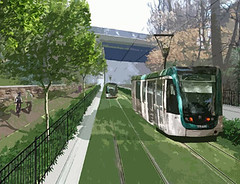
The Purple Line won’t happen without more money. Image from Maryland MTA. |
Yesterday, Maryland governor Martin O’Malley released his proposal to restructure Maryland’s gas taxes to raise $3.4 billion for transportation over 5 years. The plan is superficially similar to the recent Virginia transportation funding bill, but improves upon it in several ways.
Maryland needs new revenue this year. Without it, the Purple Line, the Corridor Cities Transitway, and the Baltimore Red Line could all stop moving forward.
The key to the bill is a new 2% wholesale tax on gasoline. Wholesale taxes differ from normal gas taxes in that the gas distributor pays them rather than the consumer. The distributor then usually passes the tax along to consumers via higher prices.
The plan partially offsets this wholesale tax by reducing the normal gas tax, from 23.5¢ per gallon to 18.5¢ per gallon. But the plan would also index the new lower gas tax to inflation, so it would increase slightly each year.
Taken together, overall tax revenue from gas would go up by about 2¢ per gallon as soon as the bill takes effect. In 2014 the 2% wholesale tax will increase to 4%, increasing gas tax revenue by another 9¢.
Maryland’s bill versus Virginia’s bill
Both bills reduce the normal gas tax but add new wholesale gas taxes. But while Virginia plans to reduce its total gas tax and subsidize highway building with revenue from other sources, Maryland’s proposal sticks to the principle of transportation user fees.
Unlike Virginia’s bill, Maryland’s does not include new fees on hybrid car owners, increases to the sales tax, nor any taxes on land or hotel visits.
Like Virginia’s bill, Maryland’s specifies that if Congress allows states to raise internet sales taxes, Maryland will do so, and will allocate some of it to transportation. If Congress doesn’t allow an internet sales tax by 2015 then Maryland’s wholesale gas tax will increase from 4% to 6%.
One thing Maryland’s proposed bill does that Virginia’s does not is to index transit fares on MTA buses and trains to inflation. That will put more burden on transit riders, but will also provide MTA with a more predictable budget.
Since Maryland cannot impose rules on WMATA without agreement from DC and Virginia, WMATA fares will not be indexed to inflation.
Smart Growth advocates are generally more supportive of O’Malley’s proposal than the Virginia bill. Montgomery County councilmember Hans Riemer says the bill “appears to be a very strong plan and just what Maryland needs to get big infrastructure projects going.”
The bill will undoubtedly face stiff opposition from Maryland Republicans, so its passage is no sure thing. But O’Malley’s proposal is co-sponsored by Senate President Mike Miller and House Speaker Michael Busch, so it is clearly a serious initiative with a real chance of becoming law.
 Cross-posted at Greater Greater Washington. Cross-posted at Greater Greater Washington.
March 5th, 2013 | Permalink
Tags: funding, government, transportation

NPS finally removes fences from McPherson Square
|
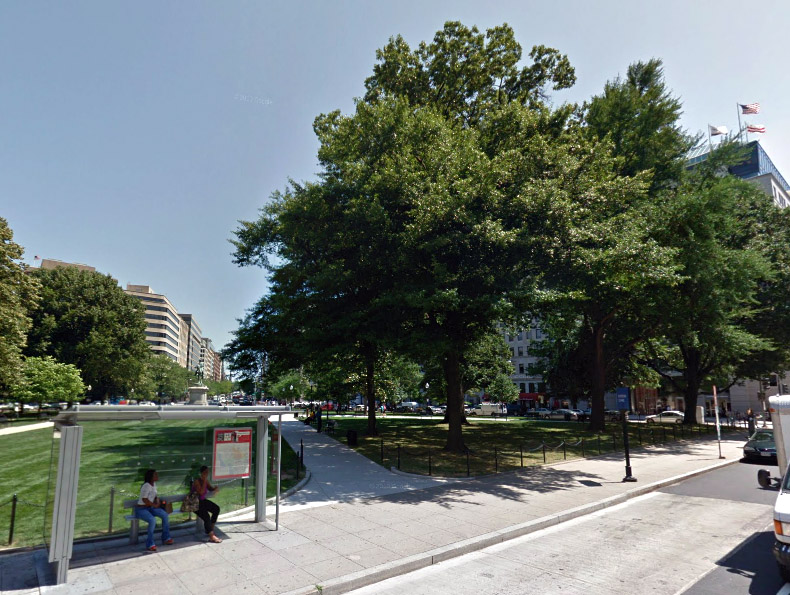
McPherson Square. Image from Google Street View. |
Sometime earlier this month the National Park Service finally removed its fences from McPherson Square. The fences had been blocking access to most of the park for about the same length of time that Occupy DC had its tents there.
Occupy DC first started using McPherson Square in October, 2011. By January, 2012 they covered the entire park, but in February the majority of campers were removed. Some tents remained until June. In total, Occupy’s tents were up in McPherson Square for about 8 months, with the heaviest concentration lasting only about 3 months.
Shortly after booting Occupy from McPherson Square, the National Park Service fenced off all the grassy portions of the square, so they could regrow grass. The grass was back by late summer 2012, but the fences remained until just recently. They were up, completely blocking anyone from using most of the park, for about 8 months. That’s as long as Occupy used the park, and more than twice as long as Occupy’s full strength.
And of course, Occupy didn’t stop anyone from using the park the way NPS did. Occupy was there, in the way, but they didn’t put up fences. Occupy never tried to physically stop other people from using McPherson Square.
This NPS “fix” was worse than the “problem”, and was the latest illustration of how NPS prioritizes grass above the people who actually use their parks.
For years NPS has managed DC’s urban parks like Yellowstone or Yosemite, treating them like nature preserves instead of social places for people. They have gotten a little better in recent years, with new leadership in charge of DC park lands, but obviously much improvement is still needed.
February 28th, 2013 | Permalink
Tags: government, parks

|
Media





Site
About BeyondDC
Archive 2003-06
Contact
Category Tags:
Partners
|

 Cross-posted at Greater Greater Washington.
Cross-posted at Greater Greater Washington.






















